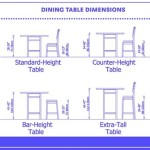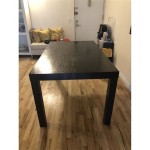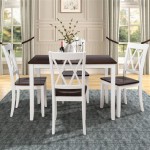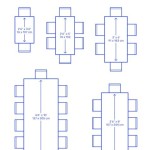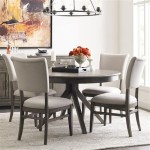Faux Concrete Outdoor Dining Table: A Durable and Stylish Addition to Your Patio
Outdoor dining tables are essential for enjoying meals and gatherings in the open air. With a wide variety of materials available, choosing the right one can be a challenge. Faux concrete outdoor dining tables have emerged as a popular option due to their aesthetic appeal, durability, and relatively low maintenance requirements. This article will explore the characteristics, advantages, disadvantages, and considerations surrounding faux concrete outdoor dining tables, providing information to aid in selecting the right table for specific needs.
Faux concrete, also known as concrete composite or lightweight concrete, is a manufactured material designed to mimic the look and feel of real concrete while offering several improvements. It typically consists of a blend of cement, fiberglass, sand, and other additives. The specific composition varies depending on the manufacturer and intended application, but the fundamental principle remains the same: to create a material that is lighter, more manageable, and often more durable than traditional poured concrete. The use of fiberglass reinforces the composite, providing increased strength and resistance to cracking, while the lighter weight simplifies transportation and installation.
Understanding the Composition and Manufacturing of Faux Concrete
The manufacturing process of faux concrete begins with carefully blending the raw materials. The proportions of cement, sand, fiberglass, and additives are crucial for achieving the desired properties of the final product. The mixture is then poured into molds, often reinforced with a fiberglass mesh for added structural integrity. Vibration techniques are used to remove air bubbles and ensure an even distribution of the material throughout the mold. Once the mixture has cured, the piece is removed from the mold and undergoes finishing processes such as sanding, polishing, and sealing. The sealing process is particularly important for outdoor furniture, as it protects the faux concrete from moisture penetration and staining.
Different types of faux concrete exist, each with slightly varying characteristics. Glass Fiber Reinforced Concrete (GFRC) is a common type, known for its high strength-to-weight ratio and durability. It utilizes a high concentration of glass fibers to reinforce the cement matrix, resulting in a material that is resistant to cracking and impact. Another type, often referred to as fiber cement, incorporates cellulose fibers instead of glass fibers. While fiber cement is generally more affordable than GFRC, it may not offer the same level of strength and weather resistance. The choice of faux concrete material impacts the longevity and suitability for specific outdoor environments.
The aesthetic qualities of faux concrete are heavily influenced by the finishing process. Manufacturers can achieve a range of textures and colors, from smooth and polished surfaces to rough and rustic finishes. Color pigments can be added to the concrete mix to create a variety of hues, allowing for customization to match different design aesthetics. The ability to replicate the look of real concrete, while also offering a wider range of design options, is a significant advantage of faux concrete.
Advantages of Faux Concrete Outdoor Dining Tables
Faux concrete outdoor dining tables offer several benefits compared to tables made from other materials, such as wood, metal, or plastic. One of the most significant advantages is their durability. The reinforced composite material is resistant to cracking, chipping, and fading, making it well-suited for outdoor use. Unlike wood, faux concrete does not rot or decay when exposed to moisture. Unlike metal, it does not rust. And unlike plastic, it is less likely to warp or crack under extreme temperatures.
Another key advantage is the aesthetic appeal. Faux concrete offers a modern and sophisticated look that blends well with a variety of outdoor settings. Its minimalist design complements contemporary styles, while its natural texture adds a touch of rustic charm. The ability to customize the color and finish further enhances its versatility, allowing homeowners to create a unique and personalized outdoor dining space. The visual weight of the material provides a sense of solidity and permanence, adding to the overall aesthetic appeal.
Maintenance is another area where faux concrete excels. Unlike wood, which requires regular sealing and staining, faux concrete requires minimal upkeep. Regular cleaning with soap and water is typically sufficient to remove dirt and debris. A sealant can be applied periodically to further protect the surface from staining and moisture penetration, but this is generally not required as frequently as with wood furniture. The low maintenance requirements make faux concrete a practical choice for busy homeowners who want to enjoy their outdoor dining space without spending excessive time on upkeep.
Finally, the relative light weight compared to real concrete is a notable benefit. While faux concrete is still heavier than, say, plastic, it is significantly lighter than solid concrete. This makes it easier to move and position the table, especially when rearranging outdoor furniture or preparing for events. The reduced weight also simplifies transportation during delivery and installation.
Considerations and Potential Drawbacks
Despite the numerous advantages, there are also some considerations and potential drawbacks to keep in mind when considering a faux concrete outdoor dining table. One of the primary considerations is cost. While faux concrete is generally more affordable than real concrete, it can still be more expensive than tables made from materials such as plastic or some types of wood. The price depends on the size of the table, the complexity of the design, and the quality of the materials used. It's important to compare prices from different manufacturers and retailers to ensure that the purchase aligns with budgetary constraints.
While faux concrete is durable, it is not indestructible. It can be susceptible to scratching and chipping, especially if subjected to rough handling or heavy impacts. Proper care and handling are essential to prevent damage. Using placemats and coasters can help protect the surface from scratches caused by tableware. Avoiding dropping heavy objects onto the table can minimize the risk of chipping. Although the sealant helps protect against staining from spills, it is still best to clean spills as quickly as possible to prevent permanent marks.
Another factor to consider is the potential for hairline cracks. While faux concrete is designed to resist cracking, minor hairline cracks can sometimes develop over time, particularly in areas that are subject to stress or temperature fluctuations. These cracks are usually cosmetic and do not compromise the structural integrity of the table, but they can be visually unappealing. Applying a sealant can help minimize the appearance of hairline cracks and prevent them from worsening. Regular inspection of the table can help identify any cracks early on, allowing for timely repairs.
Finally, the style of faux concrete may not appeal to everyone. While its modern aesthetic is popular, some may prefer the more traditional look of wood or the ornate designs of wrought iron. The industrial aesthetic of concrete may be considered too stark or minimalist for certain outdoor settings. It is important to consider the overall design style of the outdoor space and choose a table that complements the existing décor. Before purchasing, homeowners should carefully consider their personal preferences and the aesthetic of their outdoor space to ensure that the faux concrete table is a good fit.
In conclusion, faux concrete outdoor dining tables present a compelling option by offering a blend of durability, aesthetic appeal, and relatively low maintenance. Their resistance to the elements, coupled with a modern, versatile design, makes them suitable for a variety of outdoor settings. However, prospective buyers should consider the cost, potential for scratching and chipping, the possibility of hairline cracks, and the overall aesthetic compatibility with their outdoor space before making a purchase. By carefully evaluating these factors, one can determine if a faux concrete outdoor dining table is the right choice for enhancing their outdoor dining experience.

Abbott Concrete Acacia Round Outdoor Dining Table Pottery Barn

Palmera Rectangular Faux Cement Outdoor Dining Table World Market

Concrete Outdoor Furniture Kathy Kuo Home

Palmera Rectangular Faux Cement Outdoor Dining Table World Market

Abbott Concrete Acacia Outdoor Dining Table Pottery Barn

Portside Concrete Outdoor Dining Table West Elm Australia

Concrete Indoor Outdoor Pedestal Round Dining Table 32 60 West Elm

Concrete Outdoor Dining Furniture Sets Pottery Barn

Palmera Rectangular Faux Cement Outdoor Dining Table

Diy Faux Concrete Round Outdoor Dining Table Simple Made Pretty 2024

